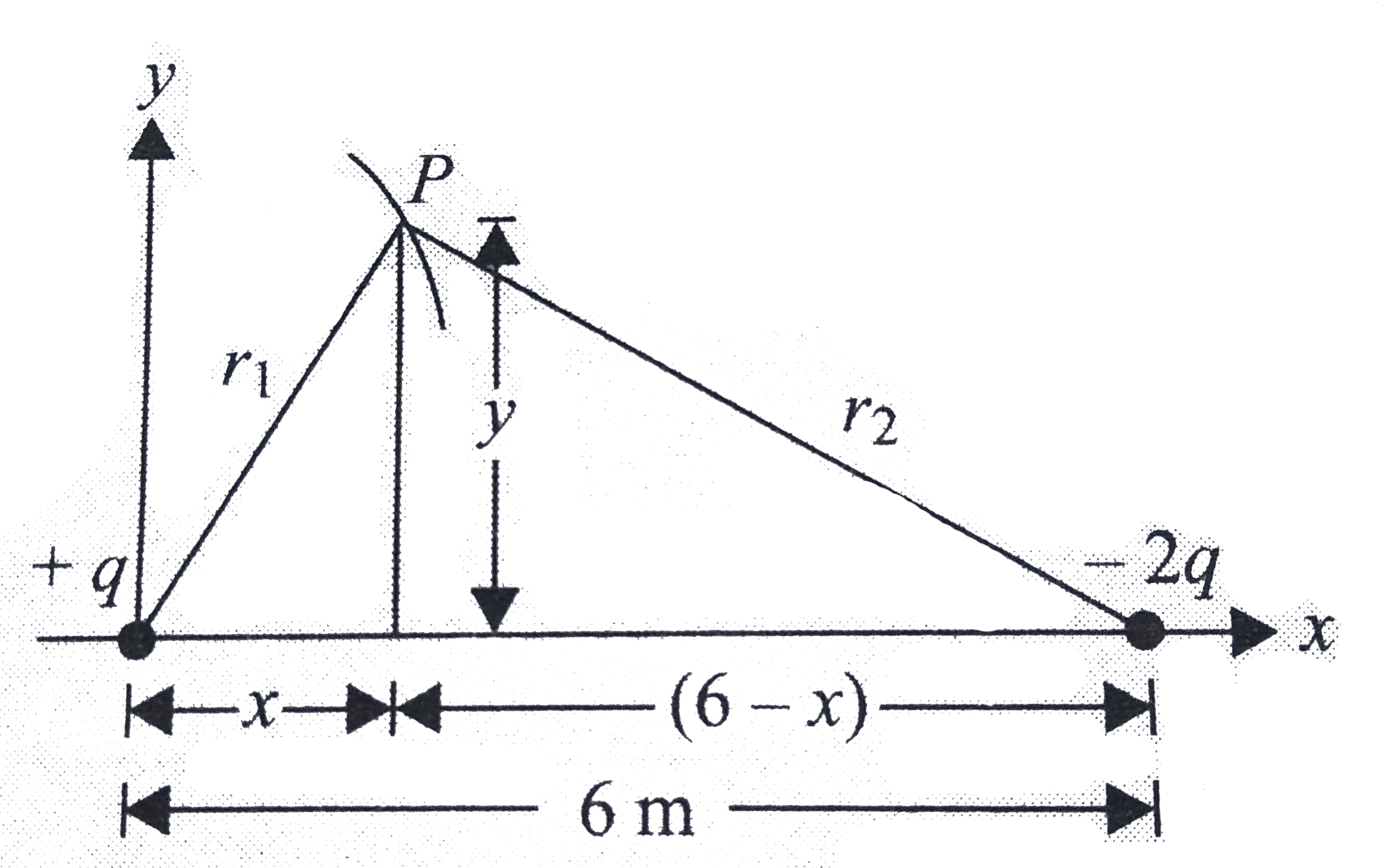Charges Q and -2Q are placed at some distance. The locus of points in the plane of the charges where the potential is zero will be :
To solve the problem of finding the locus of points in the plane of two charges Q and −2Q where the electric potential is zero, we can follow these steps:
1. Define the Charges and Their Positions:
- Let charge Q be placed at the origin (0,0).
- Let charge −2Q be placed at point (a,0) on the x-axis, where a is the distance between the two charges.
2. Identify a Point P in the Plane:
- Consider a point P with coordinates (x,y) in the plane where we want to find the potential.
3. Calculate the Distances from Point P to the Charges:
- The distance from point P to charge Q is given by:
r1=√x2+y2
- The distance from point P to charge −2Q is given by:
r2=√y2+(a−x)2
4. Write the Expression for Electric Potential at Point P:
- The electric potential V at point P due to charge Q is:
V1=kQr1=kQ√x2+y2
- The electric potential V at point P due to charge −2Q is:
V2=k(−2Q)r2=−2kQ√y2+(a−x)2
- Therefore, the total potential V at point P is:
V=V1+V2=kQ√x2+y2−2kQ√y2+(a−x)2
5. Set the Total Potential to Zero:
- For the potential to be zero:
kQ√x2+y2−2kQ√y2+(a−x)2=0
- This simplifies to:
1√x2+y2=2√y2+(a−x)2
6. Cross-Multiply and Simplify:
- Cross-multiplying gives:
√y2+(a−x)2=2√x2+y2
- Squaring both sides results in:
y2+(a−x)2=4(x2+y2)
- Expanding and rearranging leads to:
y2+a2−2ax+x2=4x2+4y2
- This simplifies to:
3y2+3x2+2ax−a2=0
7. Rearranging to Standard Form:
- Rearranging gives:
4x2+2ax+3y2=a2
- Dividing through by a2 gives:
4x2a2+3y2a2+2xa=1
8. Identify the Locus:
- The equation resembles the standard form of an ellipse:
(x+a4)25a28+y25a212=1
- Thus, the locus of points where the potential is zero is an ellipse.
Final Answer:
The locus of points in the plane of the charges where the potential is zero will be an ellipse.
- Let charge Q be placed at the origin (0,0).
- Let charge −2Q be placed at point (a,0) on the x-axis, where a is the distance between the two charges.
- Consider a point P with coordinates (x,y) in the plane where we want to find the potential.
- The distance from point P to charge Q is given by:
r1=√x2+y2
- The distance from point P to charge −2Q is given by:
r2=√y2+(a−x)2
- The electric potential V at point P due to charge Q is:
V1=kQr1=kQ√x2+y2
- The electric potential V at point P due to charge −2Q is:
V2=k(−2Q)r2=−2kQ√y2+(a−x)2
- Therefore, the total potential V at point P is:
V=V1+V2=kQ√x2+y2−2kQ√y2+(a−x)2
- For the potential to be zero:
kQ√x2+y2−2kQ√y2+(a−x)2=0
- This simplifies to:
1√x2+y2=2√y2+(a−x)2
- Cross-multiplying gives:
√y2+(a−x)2=2√x2+y2
- Squaring both sides results in:
y2+(a−x)2=4(x2+y2)
- Expanding and rearranging leads to:
y2+a2−2ax+x2=4x2+4y2
- This simplifies to:
3y2+3x2+2ax−a2=0
- Rearranging gives:
4x2+2ax+3y2=a2
- Dividing through by a2 gives:
4x2a2+3y2a2+2xa=1
- The equation resembles the standard form of an ellipse:
(x+a4)25a28+y25a212=1
- Thus, the locus of points where the potential is zero is an ellipse.
The locus of points in the plane of the charges where the potential is zero will be an ellipse.
Similar Questions
Two electric charges q1=qandq2=−2q are placed at a distance l = 6a apart. Find the locus of points in the plane of the charges where the field potential is zero
View SolutionTwo electric charges qand−2q are placed at a distance 6 m apart on a horizontal plane. Find the locus of point on this plane where the potential has a value zero.
 .
.
View SolutionThe point charges Q and −2Q are placed at some distance apart. If the electirc field at the location of Q is E, the electric field at the location of −2Q will be
View SolutionTwo charges q1andq2 are placed at (0,0,d) and (0,0,-d) respectively. Find locus of points where the potential is zero.
View SolutionTwo point charges Q and -3Q are placed at some distance apart. If the electric field at the location of Q is →E, the field at the location of - 3Q is
View SolutionTwo positive point charges of magnitude Q each are separated by a distance "2a". A test charge 'g0' is located in a plane which is normal to the line joining these charges and midway between them. The locus of the points in this plane for which the force on the test charge has a maximum value is
View SolutionTwo point charges 4Q, Q are separated by 1m in air. At what point on the line joining the charges is the electric field intensity zero ?
Also calculate the electrostatic potential energy of the system of charges, taking the value of charge, Q=2×10−7C.
View SolutionTwo point charges +q and −q are placed a distance x apart. A third charge is so placed that at the three charges are in equilibrium. Then
View SolutionTwo point charges Qand−Q/4 placed along the x - axis are separated by a distance r. Take −Q/4 as origin and it is placed at the right of Q. Then the potential is zero.
View SolutionTwo free point charges +qand+4q are placed apart a distance x. A third charge is so placed that all the three charges are in equilibrium. Then
View Solution
